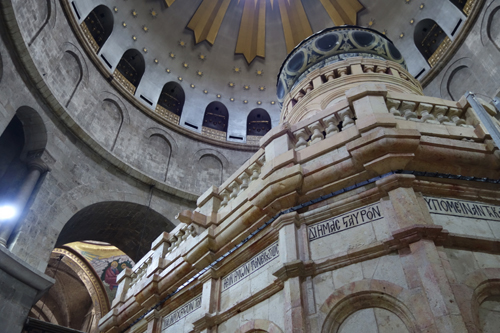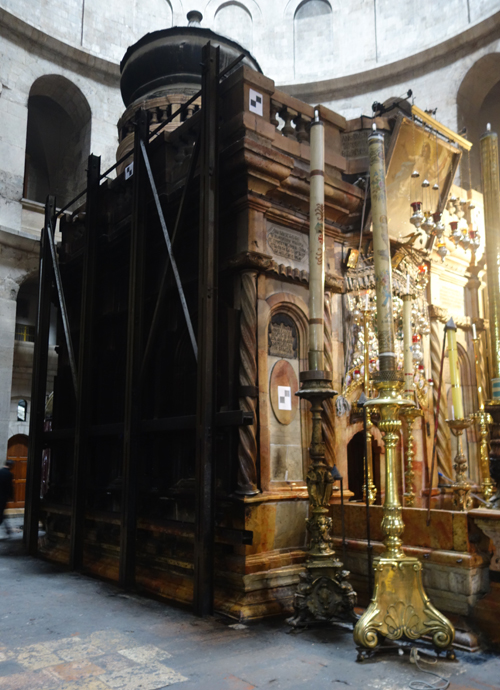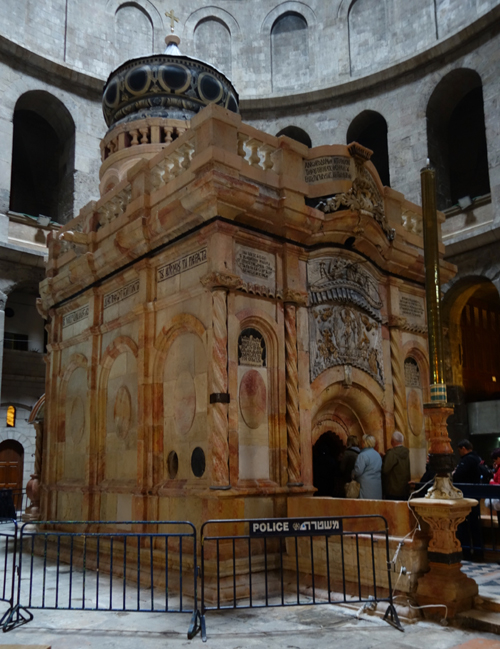
DAVID ADAMS reports on the restoration of the building known as the ‘Edicule’ in the Old City of Jerusalem’s Church of the Holy Sepulchre…
A restoration of the Edicule – a small, ornate building surrounding what tradition holds is the site of the tomb of Jesus – has been completed, it was announced this week.
Carried out by a team from the National Technical University of Athens, the restoration involved temporarily stripping away, cleaning and reinforcing the exterior marble slabs of the small building which is at the centre of the main rotunda of the Church of the Holy Sepulchre, located in the Old City of Jerusalem.


A BUILDING TRANSFORMED: Images showing the Edicule before and after restoration. PICTURE: World Monuments Fund.
The building covers the remains of what was identified in the fourth century as the rock-cut tomb where the body of Christ was laid after he was taken down from the Cross and prior to His resurrection. The Edicule – the word derives from the Latin aedicule meaning ‘little house’ – has been destroyed or damaged several times since it was first built with the current building dating from 1809.
The restoration work, which commenced in May last year, took place mostly at night so pilgrims could continue to visit the site uninterrupted. It involved removing an ugly iron cage which had been installed by British Mandate authorities around the building in 1947 as a temporary measure to help shore up the walls and restoring the building’s masonry, a job which saw each of the stone slabs in the building’s facade temporarily removed and the insertion of titanium anchors to reinforce the structure. As part of the work, an opening was created in the wall inside the tomb so that the underlying rock can be seen.
All the exterior stone and many interior surfaces were cleaned, removing black soot from decades of pilgrims lighting candles and revealing some previously obscured painted decorations. During the restoration, two marble slabs – including a 14th century marble slab carved with a cross – were temporarily slid back to reveal the actual limestone bed upon which Jesus’ body is said to have lain.
The completion of the restoration work, done in time for Easter, was announced by the Greek Orthodox, Armenian and Franciscan communities which care for the church. They marked the occasion with a ceremony this week attended by a representative of Pope Francis and the Orthodox Ecumenical Patriarch Bartholomew I.
The Greek Orthodox Patriach of Jerusalem, Theophilos III, described the restoration as an “historic moment of collaboration between the major Christian communities and others around the world”.
The year long $US4 million restoration was partly funded by the World Monuments Fund. Bonnie Burnham, of the WWF, reportedly said this week that without any intervention, there was a “very great risk” of a collapse of at least part of the building. “This is a complete transformation of the monument.”
Professor Antonia Moropoulou, who supervised the renovation works on behalf of the university, told the Associated Press that she hopes the restoration will usher in a new era of cooperation between different denominations and that those religious communities looking after the church will make some changes to customs inside the church, including stopping pilgrims from smashing their lit candles onto the Edicule’s stone wall.
Professor Moropoulou said last year that the architectural conservation which the team was implementing was “intended to last forever”.
A second phase of work, involving working below the level of the rotunda floor to ensure the long-term stability of the Edicule, is expected at a later date.
The Church of the Holy Sepulchre was constructed in the 4th century AD on the orders of the Emperor Constantine the Great. Tradition says his mother, Helena, discovered the tomb on the site – which had been occupied by a Roman temple – as well as the remains of the cross upon which Christ was crucified.





